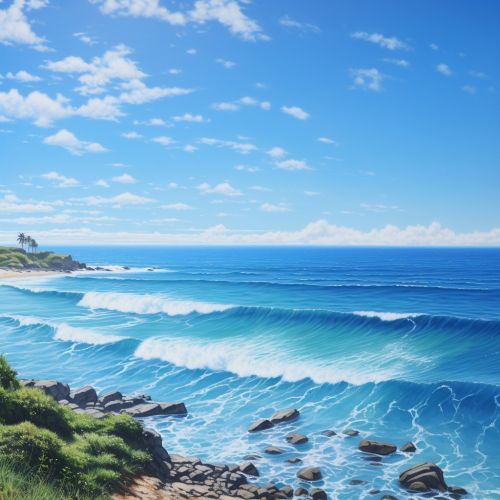Pacific Ocean
Geography and Geology
The Pacific Ocean is the largest and deepest of Earth's oceanic divisions. It extends from the Arctic Ocean in the north to the Southern Ocean (or, depending on definition, to Antarctica) in the south and is bounded by the continents of Asia and Australia in the west and the Americas in the east.


At 165,250,000 square kilometers (63,800,000 square miles) in area (as defined with an Antarctic southern border), this largest division of the World Ocean – and, in turn, the hydrosphere – covers about 46% of Earth's water surface and about one-third of its total surface area, making it larger than all of Earth's land area combined. The equator subdivides it into the North Pacific Ocean and South Pacific Ocean, with two exceptions: the Galápagos and Gilbert Islands, while straddling the equator, are deemed wholly within the South Pacific.
The Pacific Ocean encompasses approximately one-third of the Earth's surface, having an area of 165,200,000 square kilometers (63,800,000 square miles)—significantly larger than Earth's entire landmass, with room for another Atlantic Ocean to spare. The Pacific Ocean's immense size and depth influence many aspects of Earth's climate and weather. The El Niño phenomenon, for example, is a periodic fluctuation in sea surface temperature (El Niño) and the air pressure of the overlying atmosphere (Southern Oscillation) across the equatorial Pacific Ocean. These fluctuations cause changes in the wind patterns that can have far-reaching effects on the climate of areas thousands of kilometers away.
The Pacific Ocean's Mariana Trench is the deepest point in the world, reaching a depth of 36,070 feet (10,994 meters). The trench is located in the western Pacific, to the east of the Mariana Islands. The trench is about 2,550 kilometers (1,580 miles) long but has an average width of only 69 kilometers (43 miles).
Oceanography
The Pacific Ocean is a major contributor to the world's weather. It is the engine for the world's climate system, driving the global weather patterns that we all experience. The Pacific's vast expanse and enormous depth create a huge reservoir of heat, which drives the circulation of the atmosphere, distributing heat from the tropics to the poles. This circulation, known as the Hadley Cell, is a fundamental component of the Earth's weather.
The Pacific Ocean is also home to the Great Pacific Garbage Patch, a gyre of marine debris particles in the central North Pacific Ocean. The patch, which is actually two distinct collections of debris bounded by the massive North Pacific Subtropical Gyre, has been estimated to be from 700,000 square kilometers (270,000 square miles) to more than 15,000,000 square kilometers (5,800,000 square miles), depending on the degree of plastic concentration used to define the affected area.
Biodiversity
The Pacific Ocean hosts an extraordinary variety of marine life. It is home to the majority of the world's fish species and is known for its coral reefs and unique coastal ecosystems. The Pacific's Coral Triangle, a region that includes the waters of Indonesia, Malaysia, the Philippines, Papua New Guinea, Timor Leste and Solomon Islands, is considered the global center of marine biodiversity. It is home to 76% of the world's known coral species, 37% of the world's coral reef fish species, and commercially valuable species such as tuna.
The Pacific Ocean is also home to many endangered species, including the Leatherback Turtle, the Blue Whale, and the Galapagos Penguin. Efforts to conserve these species and their habitats are ongoing.
Human Interaction
The Pacific Ocean has been a vital avenue for scientific exploration, trade, and conflict. It has provided the route for explorers, traders, and military vessels. The Pacific is also a major source of livelihood for people living along its coasts. It provides food in the form of fish and shellfish, and its beaches draw tourists from around the world.
However, human activities have also had a significant impact on the Pacific Ocean. Overfishing has led to a decline in fish stocks. Pollution, particularly plastic waste, is a major issue, particularly in the Great Pacific Garbage Patch. Climate change is also causing significant changes, with rising sea levels and ocean acidification threatening many Pacific Island nations.
